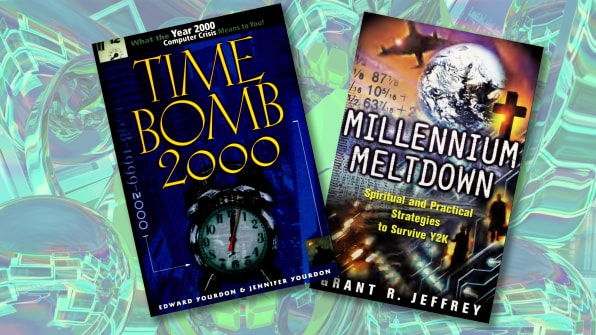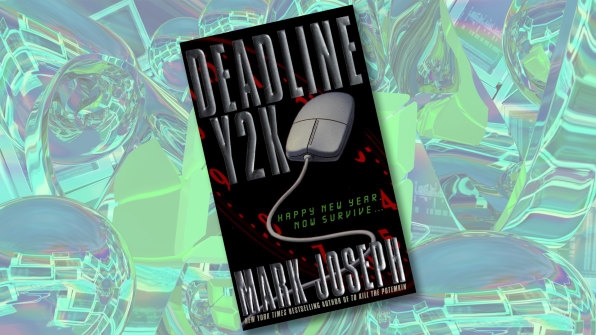The weird, wonderful world of Y2K survival guides: A look back
For a brief period in the late 1990s, it was one of the busiest categories in book publishing.
As the decade wound down, more and more people became agitated about the Y2K bug—also known as the millennium bug and the year 2000 problem–which stemmed from programmers having conserved precious bytes by storing years as two digits. (For instance, “80” instead of “1980.”) When 1999 turned into 2000, aging software reliant on such space-saving dates wouldn’t be able to tell the new year from 1900. And that raised the specter of much of the code that ran the world failing—possibly, the theory went, in disastrous ways. Power grids might be knocked out. Banks could fail. Food shortages and mass unemployment might lead to riots. Any semblance of normalcy could take years to return.
Enter a profusion of books dedicated to helping people plan for this techno-doomsday. They had scary titles like Time Bomb 2000 and The Millennium Meltdown. Their covers featured grim declarations such as “The illusion of social stability is about to be shattered … and nothing can stop it” and garish artwork of the earth aflame and bombs tumbling toward skylines. Inside, they told readers that the bug could lead to a decade or more of calamity, and advised them to stockpile food, cash, and (sometimes) weapons.

[Cover Images: Prentice Hall/Internet Archive, Wheaton Ill/Tyndale House/Internet Archive]
There were hundreds of these books from publishers large and small, some produced by people who turned the topic into mini-media empires. For example, Edward Yourdon, a well-known author of works on software engineering, cranked out three Y2K guides with his daughter Jennifer and other collaborators. Publishing executive Michael S. Hyatt wrote three of his own, one being a work of speculative fiction he coauthored. “I am convinced that the Y2K problem presents us with, potentially, the most significant, extensive, and disruptive crisis we have ever faced,” he wrote in The Millennium Bug. The book included everything from a list of paper documents to have on hand (tax returns, proof of baptism) to tips on building a latrine.
Spoiler alert: When January 1, 2000, rolled around, nothing terrible happened. By then, techies had spent years patching up creaky code so it could deal with 21st-century dates, and the billions invested in the effort paid off. Some problems did crop up, but even alarming-sounding ones—such as glitches at nuclear power plants—were minor and resolvable.
Once it was clear that theoretical crisis had been averted, bookstores shipped stacks of unsold Y2K tomes back to their publishers: “Y2K books go the way of the Edsel” read one newspaper headline. Everybody soon forgot that the category had ever existed.
Twenty years later, the books are relics of another age. Though they were a largely useless, irresponsible overreaction at the time, they’re funny and fascinating now. And they’re an eternally useful guide to how not to give people advice about technology and its role in their lives.
Millennium madness
The notion of something big happening in or about the year 2000–be it Christ’s second coming or just a random, humanity-destroying global crisis—predates the invention of computers by centuries. Isaac Newton’s posthumously published Observations Upon the Prophecies of Daniel and the Apocalypse of St. John amounted to a proto-Y2K survival guide of sorts. (He thought that Christ might return in 2000 but also said that the world could come to an end in 2060, so he hasn’t been proven entirely wrong yet.) It’s no shocker that as the big year approached—and computers threatened to cause major problems—many minds turned to the apocalyptic.
The category amounted to a giant feedback loop in which the existence of Y2K alarmism led to more of the same.”
The guides generally didn’t devote much space to an examination of the effort involved in fixing the Y2K bug. (A separate category of how-to books, such as Year 2000 Solutions for Dummies, addressed this software engineering task, typically in more levelheaded fashion.) Instead, they provided a brief layperson’s guide to the origins of the problem, and then segued into nightmare scenarios and advice for dealing with them—whether the upheaval lasted days, weeks, years, or (you can’t be too prepared) decades.
Most of the books came out remarkably similar. Even the titles reek of sameness: There was a Y2K Survival Guide, a Y2K Personal Survival Guide, a Y2K Personal Survival Kit, a Y2K Financial Survival Guide, and a Y2K Survival Guide and Cookbook. And two different Y2K Family Survival Guides—one of which featured a foreword by Leonard Nimoy, who also sleepwalked his way through hosting a VHS-tape version.
Given that the Y2K bug was an actual thing—many programmers really had been too shortsighted to craft code that would still work properly from 2000 onward, which truly could lead to unintended consequences and was indeed messy to correct—there was every reason to give regular people a guide to the potential upshot. But evidence of deep research in these books is rare. Many were crammed with quotations from other Y2K books and other sources of related punditry. Don Sabatini, author of Three Steps to Y2K Readiness for the Home and Family, explained that he was moved to write his book after reading an earlier book about the Y2K problem, while Donald S. McAlvany’s The Y2K Tidal Wave included a foreword by Grant R. Jeffrey, author of The Millennium Meltdown. The category amounted to a giant feedback loop in which the existence of Y2K alarmism led to more of the same.

[Cover Image: Frontier Research Publications/Internet Archive]
Most of the people who wrote Y2K books were not full-time technologists, let alone experts on the arcana of swatting bugs in old-school mainframe-computer languages such as COBOL. “Let me admit at the outset: I don’t have a degree in computer science,” acknowledged Michael Hyatt in The Millennium Bug. He helpfully pointed out that the same was true of Bill Gates and Steve Jobs and called himself “a part-time programming enthusiast,” arguing that his hobby was a helpful background for assessing the problem.
Oftentimes, Y2K authors seemed to approach their work with preexisting agendas. Distrust of the U.S. federal government in general—and, sometimes, then president Bill Clinton, in particular—frequently cropped up. “[J]ust as Herbert Hoover’s name is synonymous with the Stock Market Crash of 1929, so Bill Clinton’s name will become synonymous with the Computer Crash of 2000,” wrote Hyatt. In The Y2K Tidal Wave, McAlvany speculated that Clinton might be willfully discouraging companies from solving the crisis so he could declare martial law—not after the bug crippled the country, but preemptively, in late 1999. (Clinton did devote a fair amount of attention to Y2K preparation, including signing the Year 2000 Information and Readiness Disclosure Act and declaring a National Y2K Action Week.)

[Cover Image: Gold Leaf Press/Internet Archive]
Investment-advice peddler Wade Cook, the author of Wall Street Money Machine, wrote Y2K Gold Rush, whose advice on how to prep for millennium-bug disaster was simple: “Buy gold! Buy gold! Buy gold!” (Repetition his.) Whether he followed his own advice, I’m not sure. But the new millennium wasn’t kind to Cook. His company went bankrupt and he was eventually sentenced to 88 months in prison for tax-related crimes.
Technical savvy didn’t necessarily inoculate an author against millennium-bug panic. Edward Yourdon was a distinguished software architect with plenty of experience relevant to the challenge of assessing the Y2K bug’s impact. His level of Y2K gloominess waxed and waned, but he was prone to declarations such as “my own personal Y2K plans include a very simple assumption: the government of the U.S., as we currently know it, will fall on 1/1/2000. Period.”
Stranger than nonfiction
In Time Bomb 2000, Yourdon and his daughter/coauthor Jennifer kept pointing out that it was impossible to make definitive predictions about what would happen on January 1, 2000, and thereafter. But they spent even more pages raising possibilities with abandon—ranging from the U.S. Postal Service collapsing to America abandoning baseball as its national pastime.
Like many Y2K scribes, the Yourdons often seem to be having fun, as if they’re writing a horror story. And lots of books include at least a dash of fiction presented as such, in the form of second- or third-person scenarios illustrating what people might experience from January 1, 2000, onward, ranging from hassles at the ATM to power outages to death and destruction.
Here’s a sample from Time Bomb 2000:
As you reach the front door of the apartment building, you remember that you ran out of cash during the celebrations last night, so you stop at the bank on the corner to get a few dollars out of the ATM machine—but the machine gobbles up your bank card and refuses to give you any cash at all. When you reach the deli on the corners, you find it even more curious that their phone is also out of service, and that they’re operating without electricity.
Don Sabatini in Three Steps to Y2K Readiness for the Home and Family:
Finally, you are asked to come back to work. Still needing gas, you pull into a gas station only to be notified by the attendant that the system monitoring the pumps has malfunctioned due to some bug in the computer. “Besides,” he says, “the credit card authorization machine is still down too.”
Ned Vankevich, Y2K Made Simple:
The power outages lasted for weeks, and Sam didn’t have enough food and wood to outlast the shortages. His wife, June, lost their baby and almost died from malnutrition and from pneumonia brought on by the extended period without heat and electricity. Adding to the woes, Sam’s daughter, Amy, went into a deep depression from which she has yet to recover.
Jason Kelly, Y2K: It’s Already Too Late:
The gunmen forced Mark and the others through the halls of the executive conference center. They passed the Solvang Solutions logo, a golden S2 on the wood paneling. They marched through glass doors into the tile hallway, turned right, and proceeded past offices that had bustled with activity just a month prior. Now the offices sat vacant in the darkness brought by the Year 2000.
That last excerpt is actually from a Y2K-bug novel, which was a genre unto itself—and a cathartic one for authors, who could be as dystopian as they pleased without pausing to consider less hellacious outcomes. Kelly’s book ends with train crashes in Japan and the eastern U.S., riots in Los Angeles, and tanks rolling through the streets of Taipei. “My God,” the tech-entrepreneur protagonist says. “This is only the beginning.” In November 1999, NBC aired Y2K: The Movie, which explored similar territory.
Meanwhile, Kirkus Reviews praised another Y2K novel, Mark Joseph’s Deadline Y2K, for offering “havoc worthy of a Godzilla film.” That’s also an apt description of many Y2K guides that, though nominally nonfiction, describe chilling scenarios such as the bug leading to chemicals entering water systems and causing mass death.
In books that weren’t officially works of pure imagination, the over-the-top fearmongering often continued on into the advice about how to prep for a world devastated by Y2K. In What Will Become of Us: Counting Down to Y2K, Julian Gregori predicted that 7 out of 10 Americans would lose their livelihoods. He told readers to sell all their mutual funds and “luxury possessions,” buy a pre-1980 car, move to the country, and take up sharecropping. He also advised even the religiously agnostic to find a good church. (It’s the rare Y2K guide that’s entirely devoid of a spiritual component.)

[Cover Image: St. Martin’s Press/Internet Archive]
Other authors filled pages with lists of items to hoard, from down blankets to toilet paper. Jerry MacGregor and Kirk Charles’s The Y2K Family Survival Guide said that a family of four would need such foodstuffs as 40 pounds of potatoes, 15 pounds of dried beans, 90 pounds of vegetables, 12 loaves of bread, 4 pounds of coffee, and a gallon of shortening. That would be enough to get through a month of crisis, though the authors also provided tips for lengthier periods of upheaval (“Dairy products can be obtained by owning cows or goats”).

[Cover Images: Literary Agency of the Academic Freedom Foundation/Internet Archive, Paraclete Press/Internet Archive]
Ned Vankevich, the author of Y2K Made Simple, scoffed at “predictions of ‘Doomsday,’ ‘Armageddon,’ social violence, and mass destruction.” But he recommended taking up hobbies that didn’t require electronic devices, such as crocheting and singing, and cheerfully pointed out that the absence of power would provide an opportunity to catch up on dead-tree reading.
Paging Nostradamus
Even the most melodramatic Y2K authors realized there was a chance that the Y2K bug might turn out to be a vastly smaller whoop than they’d prognosticated. They mostly seemed concerned that such an outcome would be embarrassing, and went only so far in hedging their bets. In Time Bomb 2000, for instance, Edward Yourdon and Jennifer Yourdon brought up the possibility that “nothing will go wrong at all” and allowed that they might “be justifiably criticized for needless scare-mongering.” But they called that scenario “very unlikely.”
The very act of writing a Y2K guide for consumers prompted authors to veer far from reality.”
Scouring these books, it became obvious that the very act of writing a Y2K guide for consumers prompted authors to veer far from reality, and do so at great length. After all, if Ed Yourdon had wanted to argue that “nothing will go wrong at all,” he wouldn’t have needed to write one book, let alone three of them. (It may not be a coincidence that shorter-form Y2K bug coverage in newspapers and magazines tended to be much, much calmer.)
The only Y2K guide I’ve seen that landed on a genuinely sensible conclusion is Dave Hunt’s Y2K: A Reasoned Response to Mass Hysteria. It addressed the topic through a religious lens and contemplated dark what-ifs with the best of them—”Is Y2K God’s fitting justice?”—but concluded that programmers had the situation under control and that the year 2000 would arrive without catastrophe or even significant inconvenience. When that turned out to be the case, Hunt’s advice held up just fine:
Don’t panic. Don’t take drastic action. Don’t base any action upon the cries of alarm. Act reasonably. We should all be prepared for short-term disasters such as earthquakes, hurricanes, fire, and flood. That will cover you for the worst that could come out of Y2K.
If Hunt could get the Y2K bug right, it’s fair to criticize other authors for getting it so absurdly wrong. They all fed the hysteria—even the ones who explicitly denied wanting to do so.
Then again, Y2K authors failed to terrify average Americans, who remained largely blasé about the whole “crisis.” The Millennium Bug and Time Bomb 2000 were bona fide New York Times best sellers, but it’s clear that many Y2K guides languished on shelves. After the new year arrived safely, a Barnes & Noble clerk told the New York Daily News‘s Bill Bell that the category had been a bust: “Maybe they bought bottled water, but they sure didn’t buy any of the books.”
And think of the tech-dystopia books authors could have written if they weren’t busy churning out a glut of look-alike Y2K manuals. They could have warned readers that the 21st century would be a time of online blackmail, epic hacks, big lies that put children’s health at risk, and even cyberterrorism and new forms of propaganda that would attack our very democracy.
Hey, people might have laughed at such predictions in 1999–but there’s always a market for pessimistic futurism. They probably would have sold at least as well as Yet Another Y2K Survival Guide. And wouldn’t it have felt good to have the last laugh?
This is the fifth installment in The Design of Y2K, a series telling the stories behind the most influential products of the late 1990s and early 2000s. Read the rest of the stories here.
Fast Company , Read Full Story
(22)



